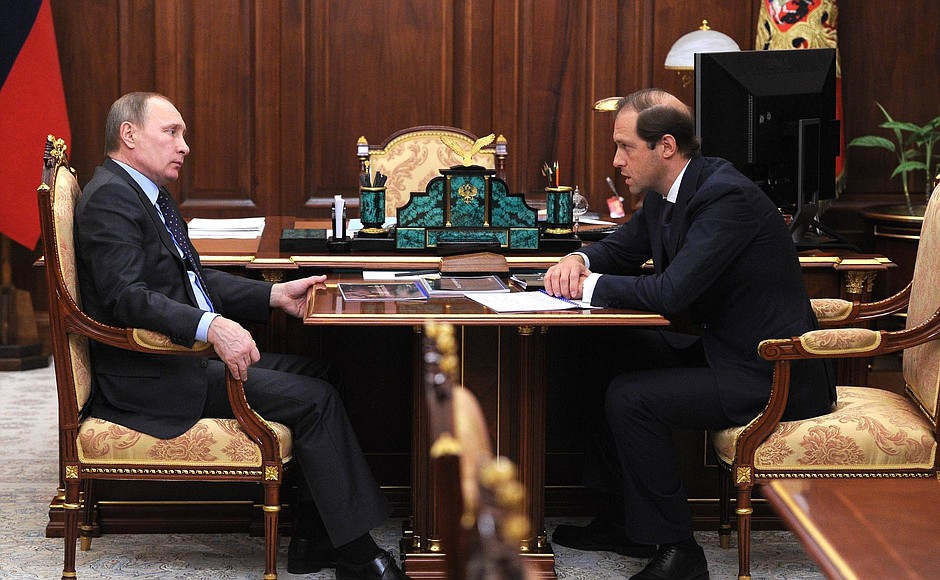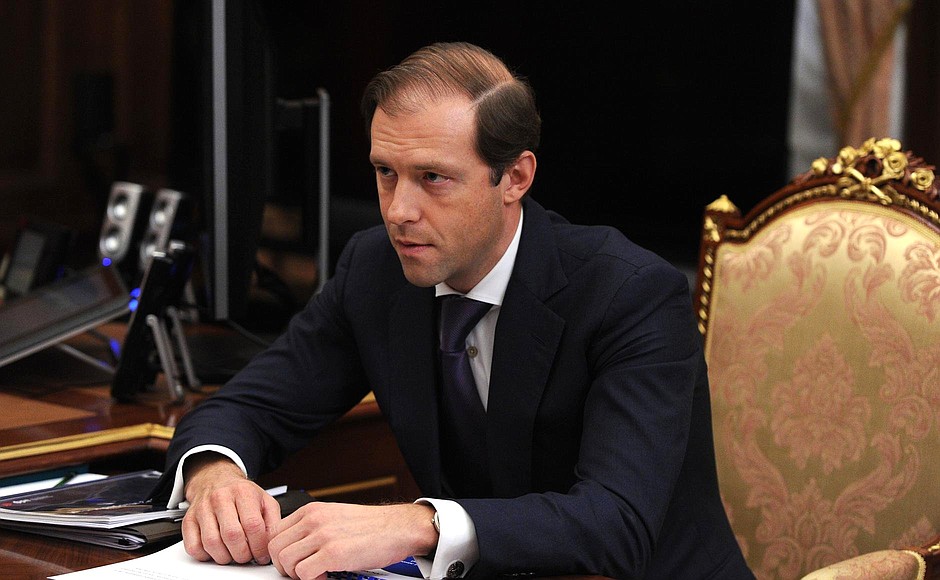President of Russia Vladimir Putin: Mr Manturov, we know the preliminary results of the industrial sector’s work. We are down by around 3.3–3.4 percent, isn’t that so?
Trade and Industry Minister Denis Manturov: The industrial output index is down by slightly more than three percent, and the processing industry is down by slightly more.
Vladimir Putin: But overall, it’s 3.3–3.4?
Denis Manturov: Yes.
Vladimir Putin: The causes for this decrease are clear enough overall, but I nonetheless want to hear your assessment of the reasons for this drop. That is my first point.
Second, what measures is your ministry taking, together with the Government, and what is their term? Are these mid-term and short-term measures? What instruments did you develop and use last year? What are your upcoming plans, including for this year?
Denis Manturov: In a bid to offset the problems in the economy and the drop in industrial output, the Government carried out an effective anti-crisis plan last year for supporting the real sector industries for which our ministry is responsible. The measures concerned above all the automotive sector and agricultural engineering. The measures taken included separate subsidies and a programme to compensate interest rates on loans to bring working capital into industrial companies. More than 180 companies benefited from this support. This enabled them to stay afloat and carry out their production plans.
We think that the experience gained and progress made not just with the current support measures, but also with the main systemic mechanisms and the passage of the law on industrial policy lay the foundations we need to develop our industries not just in 2016, but in the mid-term perspective.
Vladimir Putin: Which mechanisms, specifically?
Denis Manturov: As far as the new law goes, its implementation saw the establishment of a new development institute – the Industry Development Fund. In less than a year, this development institute has become a very dynamic and useful instrument for bringing in investment and preferential loans for industrial companies. Seventy-four projects in different sectors received the fund’s support. They include the main engineering sectors, pharmaceuticals, radio-electronics and new materials.
These projects created more than 10,000 new, highly productive jobs. An additional 600 billion rubles worth of new output will be sold by 2020. This provides new tax revenue of around 50 billion rubles for the federal budget alone.
This year, together with the Central Bank, we are launching a new programme with the fund to ensure leasing on preferential terms. This is extremely important for modernising small and medium-sized businesses.
Vladimir Putin: What does this involve?
Denis Manturov: It is about leasing technical equipment in order to either launch new projects or modernise existing industrial companies.
We think that creating a network of industrial parks is one of the biggest priorities today. Seventy-eight such parks have already been established in different regions and are in operation. Another 46 parks are in the process of development and will be completed and ready to receive new residents by 2017.
Our plans for the regions’ ongoing industrial development involve implementation of a new mechanism that is also provided for in the law on industrial policy. I am referring to special investment contracts that offer federal and regional budget preferences to investors, both Russian and foreign. This will make it possible for companies to buy equipment produced within the framework of these special investment contracts. They will also benefit from faster amortisation, which will motivate the consumer sectors to purchase this equipment.
Most important of all, I think, is that the federal and the regional authorities guarantee that the conditions for doing business will not change over the investment contracts’ ten-year implementation period. At the same time, business has responsibilities too: the eligible projects and contracts have a minimum threshold of 750 million rubles in own capital that investors must put into these projects. They also require a higher level of localised production and creation of new, highly productive jobs.
We have a dozen such contracts in the process of being drawn up right now. Orders are coming in. This mechanism is much needed. We think that it will help us to achieve our import replacement goals on the domestic market, but this is not all: one of the conditions we set for investors is that the projects must focus on development and production of high-tech goods that will find their place on export markets too.
Let me note that although imports fell by nearly a third last year, exports of Russian industrial products were up by 10 percent. Of course, the ruble devaluation was a big factor here, but the main factor was the systemic support measures we offered through Vnesheconombank and through Roseximbank, which is part of Vnesheconombank.
This year, the Government has already decided to extend these support measures for our exporters. This will enable them to sign new export contracts and increase production of Russian-made high-tech goods for export markets.
Looking at challenges facing the economy in general and the tasks you set for developing new growth centres in the real sector and in industry in particular, we have taken the initiative of starting work on drafting an industrial development strategy through to 2030. This document will set the main industrial development priorities, the sectors where we see growth potential, and the systemic measures we will need to take to ensure that our companies and their goods are competitive on global markets.
Vladimir Putin: A programme of this kind through to 2030 is needed, but what is the outlook for 2016?
Denis Manturov: As we see it, support measures have already been decided for several industrial sectors. In particular, we have already signed the plan for a programme to support the automotive sector. This is a sector that has a multiplying effect on other sectors. We forecast either maintaining the 2015 volumes, or even achieving a small increase. A total 600,000 cars were sold last year through this support programme, and we hope that between 600,000–625,000 cars will be sold this year.
The same approach will be taken in other industrial sectors. This includes agricultural engineering, light industry, and other sectors. We expect they will keep production volumes at last year’s level, or show signs of new growth stimulus in 2016.
<…>

